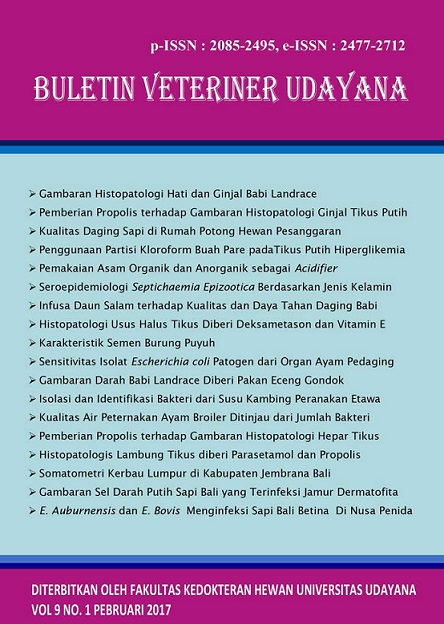THE EFFECTS OF PROPOLIS ON THE LIVER HISTOPATHOLOGY OF WHITE RATS GIVEN PARACETAMOL
Abstract
Paracetamol is one of NSAIDs (Non Steroidal Anti Inflammatory Drugs) that acts as an analgesic and antipyretic agents but with weak anti-inflammatory activity. Paracetamol has toxic effects to liver in the form of damage to the liver. To prevent the toxic effects of paracetamol, the provision of antioxidants which can protect liver cells damage caused by paracetamol is needed. High antioxidant found in propolis which is widely used at this time. This study used 25 male rats (Rattus norvegicus), which consists of five groups. Each treatment group was given standard food and drink. Group 1 (control negative) was given standard food and drink, group 2 (control positive) was given 250 mg/kg body weight of paracetamol orally, group 3 (Pp1) was given 250 mg/kg body weight of paracetamol and each rat was given 0.05 ml of propolis orally, group 4 (Pp2) was given 250 mg/kg body-weight of paracetamol and each rat was given 0.1 ml of propolis orally, and group 5 (Pp3) was given 250 mg/kg body weight of paracetamol and each rat was given 0.15 ml of propolis orally. The treatments were given for 10 days, and on the 11th day, the necropsy was done to take the livers of the 25 rats for histopathology preparation. The examined variables included vascular congestion, fatty degeneration, and necrosis with the score (0: no lesions; 1: focal lesions; 2: multifocal lesions; 3: diffuse lesions. Kruskal-Wallis test showed a significant difference on the average of the vascular congestion, fatty degeneration, and necrosis of the tested group. The result of the research, it can be concluded that the 250 mg/kg body weight of Parasetamol can cause liver damage and the 0.15 ml of Propolis for each rat could repair the tissue damage better than the dose of 0.05 ml and 0.1 ml.
Downloads
References
Bankova VS, De Castro SL, Marcucci MC. 2000. Propolis: recent advances in chemistry and plant origin. Apidologie 31(1): 3-15.
Berata IK, Winaya IBO, Adi AAAM, Adnyana IBW. 2011. Patologi Veteriner Umum. Denpasar: Swasta Nulus.
Bhadauria M. 2012. Propolis prevents hepatorenal injury induced by chronic exposure to carbon tetrachloride. Evidence-Based Complementary Altern Med 2012: 1-12.
Erguder BI, Kilicoglu SS, Namuslu M, Kilicoglu B, Devrim E, Kismet K, Durak I. 2008. Honey prevent hepatic damage induced by obstruction of the common bile duct. World J Gastroenterol 14(23): 3729-3732.
Hegazi A, Raboo F, Shaaban D, Shaaban D, Khader D. 2012. Bee venom and propolis as a new treatment modality in patients with psoriasis. Int J Med Sci 1: 27-33.
Lee WM. 2003. Drug-induced hepatotoxity. Nutr Engl J Med 349: 74-85.
Lestari IKA, Nazip K, Estuningsih S. 2014. Test of effectiveness of antibacterial of ethanol extract of loranthus of tea (Scurulla atropurpurea BL Danser) on the growth of Enterobacter sakazakii. International Conference on Food, Biological and Medical Sciences (FBMS-2014) Bangkok (Thailand) pp: 10-15.
Li S, Tan HY, Wang N, Zhang ZJ, Lao L, Wong CW, Feng Y. 2015. The role of oxidative stress and antioxidants in liver diseases. Int J Mol Sci 16: 26087-26124.
Ojo OO, Kabutu FR, Bello M, Babayo U. 2006. Inhibition of paracetamol-induced oxidative stress in rats by extract of lemongrass (Cymbropogon cittratus) and green tea (Camelia sinensis) in rats. J Biotechnol 5(12): 1227-1232.
Salatino A, Teixeira ÉW, Negri G, Message D. 2005. Origin and chemical variation of Brazilian propolis. E CAM 2: 33-38.
Steel RGD, Torrie JH. 1980. Principles and Procedures of Statistics, 2nd Ed. New York: McGraw-Hill.
Suastika P. 2011. Efek pemberian buah merah (Pandanus conoideus) terhadap perubahan histopatologik ginjal dan hati mencit pasca pemberian paracetamol. Bul Vet Udayana 3(1): 39-44.
Swarayana IMI, Sudira IW, Berata IK. 2012. Perubahan histopatologi hati mencit (Mus musculus) yang diberikan ekstrak daun ashitaba (Angelica keiskei). Bul Vet Udayana 4(2): 119-125.
Wollenweber E, Hausen BM, Greenaway W. 1990. Phenolic constituents and sensitizing properties of propolis, poplar balsam and balsam of Peru. Bul Liaison Groupe Polyphenols 15: 112-120.
Zhao JQ, Wen YF, Bhadauria M. 2009. Protective effects of propolis on inorganic mercury induced oxidative stress in mice. Indian J Exp Biol 47(4): 264-26.





